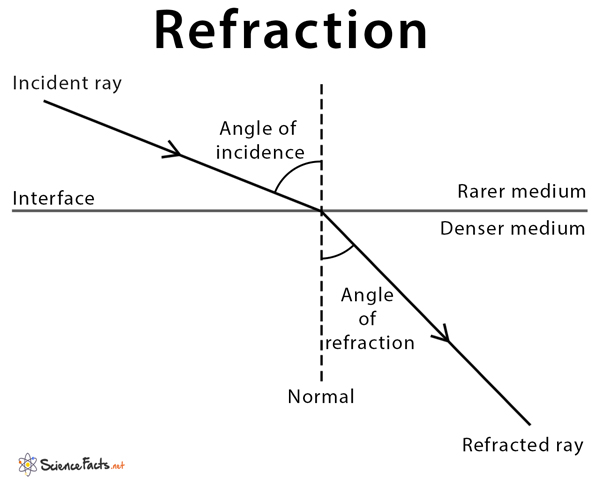Refraction
Definition: What is Refraction?
Refraction is a phenomenon when a ray of light traveling through a medium changes (bends) its direction upon entering into another medium. The two media are separated by an interface through which the ray enters the second medium. Refraction is a commonly occurring everyday phenomenon. Rays of light passing through the air are refracted by a denser medium like glass or water. Lenses and mirrors, for example, are used in many optical systems that can bend light. Refraction can also be applied to electromagnetic waves since they can pass through some mediums.
Source: Britannica.com
Examples of Refraction
- Bending of the sun’s rays as they enter raindrops, forming a rainbow
- When watching a fish angularly underwater, the light gets refracted by water
- Camera lens, eyes, and contact lens refract light and project an inverted image
- Paperweight made out of glass slab refract rays coming from the paper and hence, the paper appears elevated
- Light refracting from a glass bowl gives an apparent view of the object (e.g., submerge a pencil or straw in a bowl of water, it will look broken)
- Prism can bend and disperse light by refraction
Why Does Refraction Occur?
Light or wave traveling from one medium to another changes its velocity upon refraction. This change in velocity causes light to bend towards or away from the normal. If it is traveling from a rarer medium to a denser medium, then the light will bend towards the normal. If it is traveling from a denser medium to a rarer medium, then the light will bend away from the normal. The change in velocity also changes the wavelength, but its frequency remains the same.
Ray Diagram For Refraction
Terms Associated With Refraction
- Incident Ray: The ray of light that is incident on the interface.
- Refracted Ray: The ray of light that is refracted at the interface.
- Normal: An imaginary line perpendicular to the interface.
- Angle of Incidence: The angle that the incident ray makes with the normal.
- Angle of Refraction: The angle that the refracted ray makes with the normal.
- Refractive Index: The ratio of the velocity of light in air to its velocity in the medium.
- Refractive Power: The degree to which a lens, mirror, or other optical system converges or diverges light.
Laws of Refraction
- The incident ray, the refracted ray, and the normal lie in the same plane.
- Snell’s law: It is an equation connecting the angles of incidence and refraction with the refractive indices of the two mediums. Snell’s law is used to find the angle of refraction or the refractive index of a material (e.g., a glass slab).
Refractive Indices of Common Materials
| Material | Refractive index, n |
| Air | 1 |
| Water | 1.33 |
| Kerosene | 1.39 |
| Acrylic | 1.49 |
| Glass | 1.5 |
| Polycarbonate, polystyrene | 1.59 |
| Plastic | 1.3 – 1.7 |
| Sapphire | 1.762 – 1.778 |
| Diamond | 2.42 |
| Silicon | 3.42 – 3.48 |
| Germanium | 4.05 – 4.01 |
Applications of Refraction
- Refracting telescope: A type of optical telescope that has a lens at the front, then a long tube, and then an eyepiece at the rear, where the telescopic view of the object comes to focus. Also known as refractors, it is used to observe distant astronomical objects like the moon, stars, and planets.
- Eyeglasses: Refraction is very common in eyeglasses or spectacles. Eyeglasses are corrective lenses that allow the incoming light to focus and fall on the retina. After performing an eye test, also known as refraction test, doctors prescribe eyeglasses to patients suffering from eye disorders like myopia, hypermetropia, or presbyopia.
- Refractive surgery: A non-essential eye surgery used to improve the refractive state of the eye and decrease or eliminate dependency on glasses or contact lenses.
- Water wave: Refraction is observed in water waves. The most significant property of water that would affect the speed of waves traveling on its surface is the depth of the water. Water waves travel fastest when the medium is the deepest.
FAQs
Ans. When a beam of unpolarized light passes through anisotropic crystals such as quartz or calcite, the beam will split up into two refracted beams. This phenomenon is known as double refraction or birefringence.
Ans. If the incident ray is parallel to the normal, then the angle of incidence is 90°, and the ray enters the second medium without any deviation. This phenomenon is known as normal refraction.
Ans. Refraction is considered as a wave that bends at the interface and changes direction and wavelength.
Article was last reviewed on Tuesday, April 21, 2020









